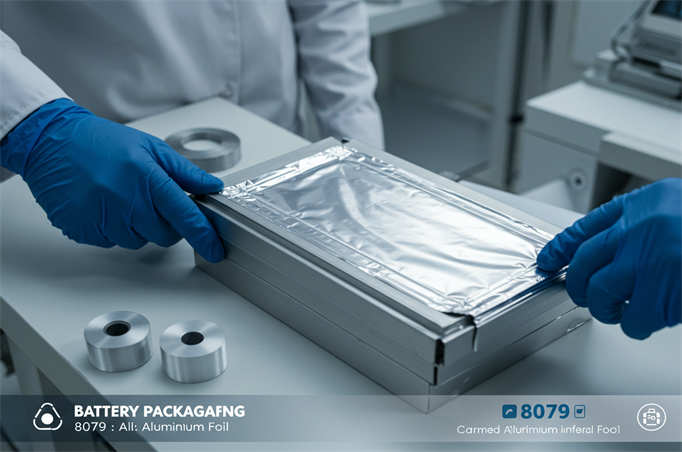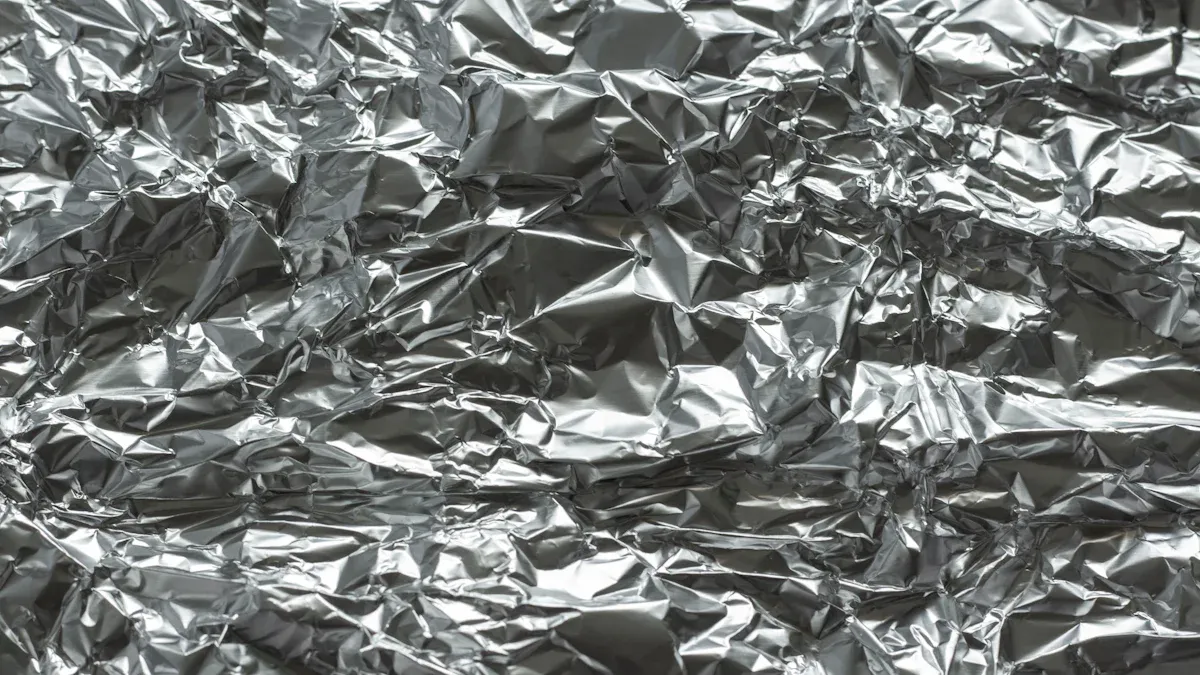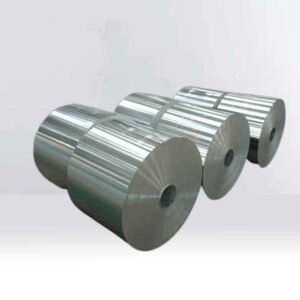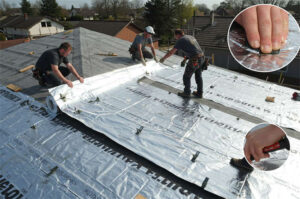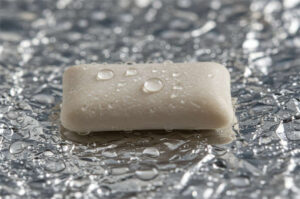Have you ever thought about using foil the right way? Many people confuse tin foil vs aluminum foil. Some think the shiny side cooks food better. Learning the truth about foil helps you cook safely. It helps you store food the right way. It also helps you protect the environment. People in different countries use foil in different ways.
Principales conclusiones
- El papel de aluminio es safe for cooking and storing food. Do not use it with acidic foods at high heat. This can stop aluminum from getting into your food.
- Puede recycle aluminum foil if it is clean. Recycling saves energy. It also helps lower pollution.
- Both sides of aluminum foil work the same way. You can use either side for cooking. You do not need to worry about which side you use.
Tin Foil vs Aluminum Foil: What’s the Difference?
History of Tin and Aluminum Foil
People often ask about tin foil vs aluminum foil. Long ago, people wrapped food with tin foil. Tin foil was common in the early 1900s. It worked, but it made food taste odd. In the 1920s, companies started using aluminum foil. Aluminum was cheaper and easier to make. By the 1940s, most people used aluminum foil. The debate about tin foil vs aluminum foil faded. By 1950, stores almost never sold tin foil.
Let’s check out the main differences between tin foil vs aluminum foil:
| Propiedad | Papel de aluminio | Papel de aluminio |
|---|---|---|
| Composición | Made of aluminum or aluminum alloy | Made of metal tin |
| Densidad | 2,70 g/cm³ | 5.75 g/cm³ |
| Melting Point | 660 °C | 231.89 °C |
| Boiling Point | 2327 °C | 2260 °C |
| Apariencia | Silver-white light metal | Silver-white micro-striped blue metal |
| Ductility and Malleability | High ductility and malleability | Excellent ductility and malleability |
| Resistencia a la corrosión | Forms an oxide film in humid air | Good corrosion resistance |
| Behavior when heated | Remains ductile | Becomes brittle above 160 °C |
Why Aluminum Replaced Tin
The switch from tin foil vs aluminum foil happened for many reasons. Aluminum foil is lighter and costs less. It is easy to bend and shape. It does not change how your food tastes. During World War II, people needed tin for other things. So, aluminum foil became the main choice. Companies like Reynolds Metals made it easy to buy. This changed how people cooked at home.
Now, when you hear tin foil vs aluminum foil, it means aluminum foil. People use it for cooking and storing food. It is strong and bends easily. It does not make your food taste different. Next time you use foil, remember its history!
Aluminum Foil Myths: Shiny vs Dull Side
Does the Side Matter for Cooking?
You might have heard the myth that the shiny side of aluminum foil cooks food better than the dull side. Maybe you’ve wondered if you should wrap your baked potato with the shiny side out or in. Here’s the truth: it doesn’t matter which side you use. The shiny side does not reflect heat better than the dull side. Scientists have tested this idea. They found that both sides of aluminum foil reflect heat almost the same way. When you use foil in your oven or on the grill, you get the same results no matter which side faces the food.
Tip: You can stop worrying about which side of aluminum foil touches your food. The performance stays the same, so just use whichever side you like!
Some people believe that using the shiny side will make their food crispier or cook faster. This is one of the most common aluminum foil myths. The difference in reflectivity between the two sides is so small that you won’t notice any change in your cooking.
How Foil Gets Two Sides
Have you ever wondered why aluminum foil has a shiny side and a dull side? The answer comes from how it’s made. During the manufacturing process, two sheets of foil are rolled out together. The side that touches the rollers becomes shiny. The side that touches another sheet of foil stays dull. This process helps prevent the foil from breaking.
- The shiny side forms when the foil touches the rollers.
- The dull side forms when two sheets are pressed together.
- No special coatings or chemicals are used—just simple physics!
So, the next time you grab a sheet of aluminum foil, remember that the two sides are just a result of how it’s made. You don’t need to worry about which side to use. Focus on enjoying your cooking instead!
Is Aluminum Foil Safe for Food?
Food Safety and Regulations
Do you use aluminum foil a lot? You might wonder if it is safe for food. The FDA and the World Health Organization have checked this. They say it is safe if you do not get too much aluminum. If you get less than 2 mg per 2.2 pounds of your weight each week, it is fine. Aluminum foil does not make your food unsafe. It can add a very small amount of aluminum to your food. Experts say this tiny bit is not a problem. The FDA says the amount that gets into food is still safe.
Nota: You can use aluminum foil for sandwiches, leftovers, or baking. Just do not use too much. That is the best way to stay safe!
Using Foil with Acidic Foods
There is something important to know about aluminum foil. Some foods do not work well with it. Foods like tomatoes, vinegar, and citrus are acidic. These foods can react with aluminum foil. This can make the foil break down. Your food might taste metallic. More aluminum can get into your food.
- Do not use aluminum foil with very acidic or salty foods.
- Acid or salt can pull aluminum from the foil into your food.
- This happens faster when you cook at high heat.
Look at this table to see when aluminum foil is safe and when to be careful:
| Condition | Aluminum Leaching | Riesgos sanitarios |
|---|---|---|
| Cold use (e.g., wrapping food) | No | Ninguno |
| Heated use | Sí | Osteoporosis, neurodegenerative diseases |
| Contact with acidic foods | Sí | Increased leaching, potential gastric irritation |
| High temperatures | Sí | Higher leaching rates, long-term health risks |
If you want to keep your food safe, do not use aluminum foil with acidic foods at high heat. For other foods, aluminum foil is still a good kitchen tool.
Can You Recycle Aluminum Foil?
You probably use aluminum foil almost every day. You might wrap food or cover pans. But what should you do when you are done? Many people ask if aluminum foil can be recycled. The answer is yes, but you must do it the right way.
How to Recycle Foil Properly
You can recycle aluminum foil if it is clean. Food or grease can ruin recycling. Here is what you should do:
- Rinse the foil to get rid of food or liquid.
- Flatten the foil to save space in the bin.
- Make sure there is no food left on the foil before recycling.
Tip: If your foil is too dirty to clean, throw it away instead of recycling.
In Europe, more than 75% of aluminum packaging gets recycled. The average recycling rate for all aluminum packaging in Europe is over 60%. You can help these numbers go up by recycling your foil the right way.
Impacto medioambiental
Aluminum foil is good for the environment if you recycle it. Here is a fact: aluminum foil can be recycled many times and stays strong. Recycling aluminum saves more than 90% of the energy needed to make new foil. This means less pollution goes into the air.
- Papel de aluminio protects food from light, water, and air.
- It is light, so it is cheaper to move.
- Aluminum foil is better for the environment than plastic because you can recycle it many times.
- Plastic is cheaper, but it pollutes more and is harder to recycle.
When you recycle aluminum foil, you help the earth and keep trash out of landfills. Next time you use aluminum foil, remember you can help the planet.
Aluminum Foil in the Microwave: Safe or Not?
Risks of Microwaving Foil
You might ask if it is okay to use aluminum foil in the microwave. Many people think it is fine, but you need to be careful. Using aluminum foil in the microwave can make sparks. These sparks can start a fire or break your microwave. This happens because aluminum foil is metal. Microwaves and metal do not work well together. When microwaves hit the foil, electrons move very fast. This can make sparks or even flames.
Here are some things that can go wrong if you microwave aluminum foil: * Sparks can fly and start a fire in your microwave. * The microwave can break and stop working. * Flames can show up if the foil touches the oven walls.
You should always be careful with aluminum foil in the microwave. Even a small mistake can cause big problems.
Safe Microwave Practices
If you must use foil in the microwave, you need to follow strict rules. Microwave makers and safety experts give these tips to keep you safe:
| Guidelines | Risks |
|---|---|
| Use new, smooth foil only. | Regular aluminum foil can reflect microwaves and cause sparking. |
| Cover no more than 1/4 of the food with foil. | Completely covering food can lead to uneven heating. |
| Shape the foil smoothly to the food. | Wrinkled foil can cause arcing. |
| Keep foil at least one inch from oven walls. | Can cause damage to the microwave. |
| Avoid using foil in microwaves with metal shelves. | Metal can disrupt electromagnetic waves and cause arcing. |
Never let aluminum foil touch the sides of your microwave. Always use a small, flat piece if you need to use foil. Do not cover all your food with foil. If you follow these rules, you can lower the chance of sparks or fire. Most times, it is safer to use microwave-safe containers instead of aluminum foil.
Lining Ovens with Aluminum Foil
Hazards of Oven Lining
Puedes pensar lining your oven with aluminum foil makes cleaning easier. Many people do this to catch drips or spills. But using aluminum foil in your oven can cause more problems than it solves. Oven makers warn against it for several reasons. Take a look at this table to see what can go wrong:
| Issue | Descripción |
|---|---|
| Surface Damage | Aluminum foil can scratch or chip the oven’s porcelain finish. |
| Distribución del calor | Foil can mess up how heat spreads, so food cooks unevenly. |
| Air Flow | Covering vents with foil blocks air, which hurts oven performance. |
| Overcooking | Foil reflects heat, so food can get too done or even burn. |
| Melting | Foil can melt if it touches hot surfaces, leaving a mess or causing damage. |
You also risk starting a kitchen fire. Aluminum foil is not strong enough for high heat and grease. If you use it near open flames, it can catch fire. Sometimes, foil can even trap gases like carbon monoxide, which can make your oven stop working right. You should never use aluminum foil to line the bottom of your oven or cover vents.
Safer Alternatives
You have better options than aluminum foil for keeping your oven clean. Kitchen safety experts suggest these choices:
- Parchment paper works well for baking. It does not react with food and keeps things from sticking.
- Glass or ceramic bakeware spreads heat evenly and lasts a long time.
- Silicone mats are reusable, easy to clean, and safe for high heat.
- Stainless steel or cast iron cookware gives you a safe, sturdy way to cook without using foil.
If you want to use foil in air fryers, check the manual first. Some air fryers allow it, but you must follow the rules to stay safe. For ovens, stick with these safer options. You will protect your oven and your food.
Is All Aluminum Foil Non-Stick?
Regular vs Non-Stick Foil
You might think all aluminum foil works the same way, but that is not true. Regular aluminum foil and non-stick aluminum foil have some big differences. Regular aluminum foil does not have a special coating. Food can stick to it, especially when you bake or roast. Non-stick aluminum foil has a special coating that keeps food from sticking. You do not need to add oil or spray. This makes cleanup much easier.
Here is a quick look at how they compare:
| Característica | Papel de aluminio normal | Non-Stick Aluminum Foil |
|---|---|---|
| Revestimiento | No coating | Non-stick coating present |
| Anti-adhesive properties | Food may stick | Food slides off easily |
| Limpieza | Harder to clean | Easier to clean |
| Need for grease | Often needs grease or spray | Usually does not need grease |
| Thermal conductivity | Bien | Bien |
| Prevents burning | Higher risk of burning | Reduces risk of burning |
Preventing Food from Sticking
You can stop food from sticking to aluminum foil with a few easy tricks. If you use regular aluminum foil, try brushing it with a little oil or using a non-stick spray. Place the dull side toward the food, as it sometimes helps a bit. For sticky foods like cheese or fish, non-stick aluminum foil works best. You can also use parchment paper for baking. Always let food cool before you remove it from the foil. This helps keep your food in one piece.
Tip: If you want less mess and easy cleanup, choose non-stick aluminum foil for your next meal. You will spend less time scrubbing pans and more time enjoying your food.
Aluminum Foil Blocks All Heat and Light
How Foil Reflects Heat and Light
You might think aluminum foil blocks all heat and light. The truth is, aluminum foil does a great job, but it is not perfect. When you wrap food or cover a dish, you use aluminum foil to keep things hot or cold. This works because aluminum foil reflects heat and light away from your food. In fact, aluminum foil can block up to 97% of harmful UV light. That is why you see it used to protect food and even medicine.
Take a look at this table to see how aluminum foil compares to other materials:
| Material | UV Light Blockage | Oxygen Transmission Rate | Moisture Transmission Rate |
|---|---|---|---|
| Papel de aluminio | Up to 97% | < 0.1 cc/m²·24h | < 0.1 g/m²·24h |
| Other Materials | Varía | Higher than aluminum | Higher than aluminum |
Aluminum foil also reflects heat very well. The shiny side has a reflectivity of about 86%, while the dull side is close to 88%. This means both sides work almost the same. You can use aluminum foil to keep food warm or cool, and it helps preserve quality by blocking light.
Foil’s Limitations
Even though aluminum foil blocks most heat and light, it does not stop everything. Some heat can still pass through, especially if you leave food wrapped for a long time. Aluminum foil is thin, so it does not work as well as thick insulation. If you want to keep something hot or cold for hours, you need more than just aluminum foil.
Here are a few things to remember:
- Papel de aluminio blocks most UV light, but not all of it.
- It reflects heat, but it cannot keep food hot forever.
- Air and moisture can still get in if you do not wrap tightly.
Tip: Use aluminum foil for short-term storage or cooking. For long trips or long-term storage, try using coolers or insulated bags.
Aluminum foil gives you a strong barrier against heat and light, but it is not magic. You get the best results when you use it the right way.
Aluminum Foil and Health Risks
Myths About Aluminum Leaching
Some people think using aluminum foil makes food unsafe. They worry aluminum gets into their meals. Some believe wrapping food in foil is always dangerous. But the truth is not that simple. Using aluminum foil does not always cause health problems.
Let’s see what really happens. Studies show foil can add a little aluminum to food. This happens more with high heat or acidic foods. Foods like tomatoes or lemon can cause more aluminum to move. Salt or fat can also make this happen. For example, grilling fish in foil with sour marinade adds more aluminum. A study in 2020 found normal cooking with foil can move some aluminum into food. Another test showed grill pans with acidic foods raised aluminum levels.
Real Health Considerations
Should you stop using aluminum foil? Most experts say you can use foil safely. Health groups checked the risks. They found the aluminum from foil is very low. Even eating food cooked in foil for a short time only raises body aluminum a little.
Here are some tips to help you stay safe:
- Avoid using foil with very acidic or salty foods.
- Try to cook with lower heat.
- Store leftovers in glass or plastic containers.
Remember: Aluminum foil is safe for most kitchen uses. If you follow easy steps, you can enjoy your favorite foods without worry.
If you use foil the right way, you keep your health safe and cooking easy. Now you know the real facts about this myth!
Aluminum Foil Myths: Everyday Use
Common Misunderstandings
You probably hear a new myth about aluminum foil every week. Some people say you must always use the shiny side up. Others warn you never to put aluminum foil in the microwave. Many believe lining your oven with foil is a smart move. These myths can make cooking confusing. Let’s clear things up with a quick table:
| Mito | Dato |
|---|---|
| The Shiny Side Must Face Up | Both sides work equally well for cooking, wrapping, and storing food. |
| You Can Never Use Foil in the Microwave | Aluminum foil can be used under specific conditions, such as using smooth, new foil and keeping it away from microwave walls. |
| Foil Can Be Used to Line Your Oven | Lining the bottom of your oven with foil can block air vents and create safety hazards. Instead, use it on baking sheets. |
| All Foil Works the Same in Air Fryers | Proper technique is necessary; foil should not touch the heating element and must be weighted down. |
| Aluminum Foil Isn’t Eco-Friendly | Modern aluminum foil can be surprisingly sustainable. |
You see, not every myth about aluminum foil holds up. Knowing the truth helps you use it safely and get better results in your kitchen.
Facts for Daily Life
You use aluminum foil almost every day, so it helps to know the right way. Try these tips to make your routine easier and safer:
- Wrap leftovers in aluminum foil to keep them moist and tasty. This makes reheating simple.
- Place a sheet of aluminum foil under your baking pans. It catches drips and spills but still lets air flow in the oven.
- Make a quick funnel from aluminum foil when you need to pour liquids or dry ingredients. You will have less mess.
- Clean silver items by using aluminum foil with baking soda and boiling water. Just remember, this trick does not work for fine silver or jewelry with stones.
When you know which myth is true and which is not, you can use aluminum foil with confidence. You save time, protect your food, and keep your kitchen running smoothly.
You have learned the truth about aluminum foil. Look at this table for a quick summary:
| Principales conclusiones | Descripción |
|---|---|
| Health | Cooking with aluminum foil can add aluminum to food. |
| Environment | Recycling aluminum foil helps save energy. |
Try to rinse and use foil again if possible. Feel free to share your tips or ask questions below!
Preguntas más frecuentes
Can you put aluminum foil in the freezer?
Yes, you can. Aluminum foil keeps food fresh in the freezer. Just wrap it tightly to stop freezer burn.
Does aluminum foil rust or go bad?
No, aluminum foil does not rust. It can last a long time if you keep it dry and clean.
Is it safe to cook with foil on the grill?
Yes, you can use foil on the grill. It helps stop food from sticking and makes cleanup easy. Just keep foil away from open flames.

